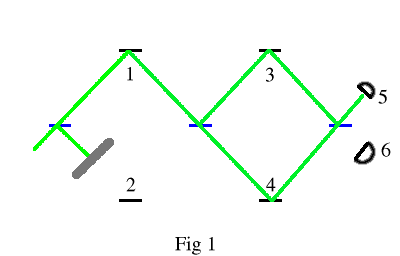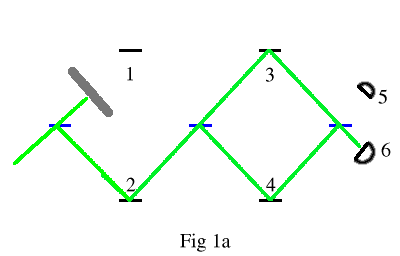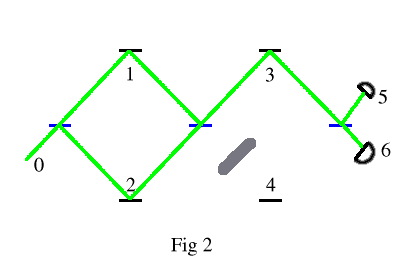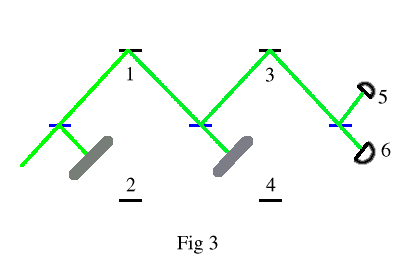
Here is a diagram of the Afshar experiment as reported in Kathy Cramer's Blog and as taken from the New Scientist article.

The experiment which Afshar claims to have done is a variant of the two
slit interference experiment. In short, a large lens focuses the light from
two slits onto two photo-detectors. A wire diffraction grating is placed
just before the lens, with the wires spaced so that they fall exactly on the
dark fringes of the interference pattern from the two slits. The argument
is that the diffraction grating, in the light which it lets through (and
the fact that the intensity of the light is not altered by the grating) has
done a measurement of the wave nature of light. The photons falling on the
detectors placed at one of the slits or the other demonstrate that the
photons came out of one of the slits or the other. Thus one has measured in
the same experiment both the wave and particle nature of the light, in
violation of Bohr's complementary principle.
Let me set up a simpler version of the experiment. As in figure 1

we have a multiple pass interferometer, where the
blue lines are half silvered mirrors and the black are fully silvered
mirrors. In each diagram the green lines are the paths of light.
A light bean comes in from direction 0, falls on the first half silvered
mirror, and is split into two. These are recombined on the second mirror,
with two possible paths, 3 and 4, which are recombined on the third mirror
with two paths 5 and 6 which fall on ideal photo-detectors.
The path lengths are arranged so that, as in figure 1, if the beam 2 is
blocked, the beam eventually entirely exits out of beam 5 and falls on its
photo-detector.

Similarly, in figure 1a, a similar situation is true if beam 1 is blocked so that photons only traverse path 2 and all of those photons finally fall on the detector in path 6. This is thus in analogy with Afshar's system where the lens is designed so that travel through slit 1 falls on photo-detector 5 and travel through slit 2 falls on photo-detector 6. The measurement of the final location of the photon thus would tell us which path, 1 or 2, the photon followed. Now as in figure 2, all absorber are removed from the beams 1 and 2. The system is arranged so that the interference at the second half silvered mirror is such that now all of the photons go on path 3. path 4, like the dark fringes in Afshar's setup, contains no photons. These will fall on detectors 5 and 6. Furthermore, one can still argue that any photon which fell on detector 5 came from path 1 and those on 6 came from 2. Now insert and absorber into the beam 4. Since there is no beam light there, no photons traveling down that path, the absorber will do nothing, and the intensities of the photons falling on detectors 5 or 6 will be unchanged.
 Afshar apparently now argues that we can now measure both the particle and
the wave nature of the photons. It is the interference (wave property)
between beams 1 and 2 which ensures no photons go down path 4. Thus in
placing the absorber into beam 4, and seeing no photons have been absorbed,
one knows then went along 3. One has measured the interference between the
two beams. By measuring which detector they triggered, 5 or 6, one measures
which of the beams. 1 or 2, the photon traveled along. Thus one has
measured two complementary properties, the "which way" or particle like property (in
Wheeler's words)-- corresponding to "which slit" in Afshar's experiment-- and the interference
between the two beams by measuring the absence of all photons on path 4.
However, while in the interference experiment, the presence or absence of
the absorber in path 4 would seem to make no difference-- no photons travel
along path 4 to be absorbed-- it makes a crucial difference in the
interpretation. A critical part of the the interpretation is drawing the
inference that IF the particle was detected in detector 5, THEN it must
have come from path 1. Similarly, IF it was detected in detector 6, then it
came from path 2. The presence of the absorber in path 4 does not change the
experiment, but it destroys these inferential chains.
Afshar apparently now argues that we can now measure both the particle and
the wave nature of the photons. It is the interference (wave property)
between beams 1 and 2 which ensures no photons go down path 4. Thus in
placing the absorber into beam 4, and seeing no photons have been absorbed,
one knows then went along 3. One has measured the interference between the
two beams. By measuring which detector they triggered, 5 or 6, one measures
which of the beams. 1 or 2, the photon traveled along. Thus one has
measured two complementary properties, the "which way" or particle like property (in
Wheeler's words)-- corresponding to "which slit" in Afshar's experiment-- and the interference
between the two beams by measuring the absence of all photons on path 4.
However, while in the interference experiment, the presence or absence of
the absorber in path 4 would seem to make no difference-- no photons travel
along path 4 to be absorbed-- it makes a crucial difference in the
interpretation. A critical part of the the interpretation is drawing the
inference that IF the particle was detected in detector 5, THEN it must
have come from path 1. Similarly, IF it was detected in detector 6, then it
came from path 2. The presence of the absorber in path 4 does not change the
experiment, but it destroys these inferential chains.

If in figure 1 we also insert an absorber into path 4-- see figure 3--, then the photon will be absorbed half the time, which is not of concern, but that of those that get through, half will be detected in 5 and half in 6. I.e., with that absorber in 4, one cannot make the inference that if the photon was detected in 5 it must have come from 1. Similarly if were were to place the absorber into path 4 in situation of figure 1a (i.e. all photons come through path 2) again of those that get through to the detectors, half fall on 5 and half on 6. I.e., while the absorber in beam 4 does not change the experimental outcomes in the full two beam experiment, it does critically change the inference one can draw from the detection at 5 or 6. All one can say in this case is that if detected in 5, it had a 50-50 chance of coming from beam 1. As a part of his complementary interpretation (NOT Copenhagen interpretation which was largely Heisenberg's construct as Don Howard has persuasively argued) Bohr continually emphasized that the conclusions one could draw from an experiment depended crucially on the whole of the experimental setup, not on bits of it. In this case the insertion of the absorber into beam 4, while it changes not a whit the experimental outcomes of that experiment, it does change the complementary interpretation of the experiment. I.e., I think Bohr would have had no problem whatsoever with this experiment within his interpretation. Nor would any other interpretation of quantum mechanics. It is simply another manifestation of the admittedly strange, but utterly comprehensible (it can be calculated with exquisite precision), nature of quantum mechanics.
In Afshar's experiment, the light from the two pinholes now spreads out and the two Airy diffraction disks overlap. It is in this region that the interference pattern is created, by the overlap of the two diffraction disks. This interference in my model is created by the second mirror. This second mirror mixes the two light signals just as is done due to the Airy disk overlap in Afshar's.
The interferenced pattern, (alternate dark and light stripes) of Afshar's situation is here replaced by the interference pattern of the two paths 3 and 4. The path 4 corresponds to the dark stripes and 3 the light stripes of his pattern. In his case the interference pattern is more complicated, because the resulting pattern is is mixed. With his setup, the strength of the light is sinusoidal. Ie, nowhere, except at the exact maxima and minima, is there no ovelap between the pattern you get now and the one you would get if you place a half-wave plate in front of one of the slits (ie changed the phase of light coming out of the pinholes to one of anti correleation rather than correlation). In my example, the light and dark patterns are cleanly separated.
In Afshar's experiment, the wires are taken to be very thin and placed in the dark spaces of the interference pattern. Ie, IF one were to do the phase shifted experiment where the pinhole light is phase shifted, the wires would only intercept part of the light. This would correspond in my case to making the absorber placed into path 4 only partially absorbtive. I will comment on this below. Finally, the lens which focuses the light from the pinholes onto the detectors acts just like the final third mirror in my experment, in separating out the light once again (undoing the interference pattern). That it does so can be seen by the fact that, as in figures 2 and 3 above, if light does come only through one pinhole, does come only through one path 1 or 2, it falls entirely on detector 5 or 6 respectively, just as if the light comes only through one of the pinholes in his case, it falls only onto one of the detectors (without the wire grid in place).
It is crucially this which allows Afshar to claim that the detectors correspond to detecting "which way" information. IF the light is known to come from one of the pinholes, then that light falls only onto the corresponding detector. Similarly, if the light goes along path 1 or 2, then the light falls only onto detector 5 or 6.
 Aug 7 2004
Aug 7 2004